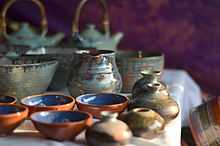Andretta, Himachal Pradesh
Andretta is a village and an artists' colony in Himachal Pradesh. The artists' colony was established in the 1920s, when Irish theatre artiste and environmentalist, Norah Richards, shifted here from Lahore. Situated near Palampur in the Kangra District, with Dhauladhar range of the Himalayas as a backdrop, Andretta over the years has attracted many noted artists, theatre practitioners, painters and more recently potters. Some of the people who became associated with it, early on were painters, Sobha Singh and B. C. Sanyal. [1]
History
Nora originally from Ireland, married Philip Richards, who was a professor at Government College, Lahore. She arrived in Lahore, then an important cultural centre, in 1908, and later became vice-principal at Dayal Singh College, Lahore. In the following years, she played a pivotal role in establishing modern Punjabi theatre, staging plays with Punjabi themes. After the death of her husband, she went back briefly, only to return in 1924, when she made Andretta, a village near Palampur, her home. Here she built a traditional Kangra-style mud house,known as ‘Chameli Niwas’, employing local style and material, using mud, slate and bamboo. she also built makeshift proscenium, and invited Punjabi theatre amateurs and professionals to perform plays.[2][3]
In 1935, District Commissioner of Kangra gave Richards 15 acres of land, and the Woodland Estate came into existence. Soon, she a school of drama, and in time the village was known as "Mem-da-pind" (Village of Memsahib). In its early days, travel to the village was not an easy task, it took 12 hours train journey, followed by bus rise, the last 9-miles from Banuri, the nearest village were covered on foot, still it started attracting artists from all over, especially Lahore. This included painter, B. C. Sanyal, and professor Jai Dayal Singh, a pupil of Philip Richards from Lahore University, through the 1940s. Sanyal started organizing painting exhibitions to fund the Nora Centre for Arts and a resort, in various cities. Also to move in was noted painter, Sobha Singh, most known for making Sikh religious painting, who stayed here till his death in 1986 [2][3] Richards nurtured Punjabi theatre through the 1940s and 1960s, and came to be known as the "gransmother of Punjabi theatre".[4]
Further on, Gurucharan Singh, a noted potter who started the Delhi Blue Pottery in the 1952, also established base here. Active till the end, he died in 1995 at the age of 99.[5] Freda Bedi, mother of actor Kabir Bedi, who converted to Buddhism, also lived at the village for a while.[1]

In 1983, Mansimran "Mini" Singh, son of noted potter Gurcharan Singh, along with his wife Mary Singh moved here, and started Andretta Pottery and Craft Society, which has a production studio pottery which produces earthen slipware and a terracotta museum. They also set and set up a Central Government Rural Marketing Centre with a grant of Rs 1,35,000 to provide assistance to potters. The society also runs three-month-long residential courses for potters. Today, pottery from Andretta is sold at outlets across India.[1][6]
Later in life, Richards was made a fellow by the Punjabi University in Patiala, while in turn she willed her house and land around it to the university. Today, the estate of Nora Richards has been renovated and maintained by the university. Each year on her birthday October 29, a Punjabi theatre festival is hosted by the students of the university.[7][8]
Andretta has become a popular tourist attraction of the region, also near by is Bir-Billing, a paragliding destination.[8] There are some homestays catering to the tourists, otherwise regular accommodations are available at Palampur, a popular tourist destination.[3][9][10]
Visitors' attractions
- Andretta Pottery and Craft Society
- Norah Richard's House
- Norah Richard's Centre for the Arts
- Sir Sobha Singh Art Gallery
Transport
Andretta is situated 20-minute drive or 13 km away from Palampur on the road towards Mandi, Himachal Pradesh. Dharamsala is at a distance of 48 km from Andretta. Nearest railway station is Pathankot, 120 km away as is the Pathankot Airport.[1]
References
- ↑ 1.0 1.1 1.2 1.3 "Himachal's pot secret". The Times of India. July 4, 2013. pp. 1–2. Retrieved 2014-02-16.
- ↑ 2.0 2.1 Charu Dogra (April 13, 2002). "Fragrant memories of Norah Richard’s Chameli Niwas". The Tribune. Retrieved 2014-02-17.
- ↑ 3.0 3.1 3.2 Charu Soni. "Andretta Artists' Village: The Irish Lahorian". Outlook Traveller. Retrieved 2014-02-17.
- ↑ "PU writers’ home at Andretta". The Tribune, Chandigarh. July 11, 2000. Retrieved 2014-02-18.
- ↑ "This above all: Master potter". The Tribune. November 14, 1998. Retrieved 2014-02-17.
- ↑ "Andretta-A sanctuary of potters". The Hindu. Jul 30, 2004. Retrieved 2014-02-18.
- ↑ Handbook of Universities. Atlantic Publishers & Dist. 2006. p. 696. ISBN 978-81-269-0608-6.
- ↑ 8.0 8.1 Aditi Banerjee (April 21, 2013). "Clay and Sky". The Indian Express. Retrieved 2014-02-18.
- ↑ Manoj Jreat (2004). Tourism in Himachal Pradesh. Indus Publishing. p. 129. ISBN 978-81-7387-157-3.
- ↑ "Homestays in Kangra". Himachal Tourism. Retrieved 2014-02-18.
Bibliography
- Anupa Lal (1998). Pottery and the Legacy of Sardar Gurcharan Singh. Delhi Blue Pottery Trust. ISBN 978-81-900931-0-1.